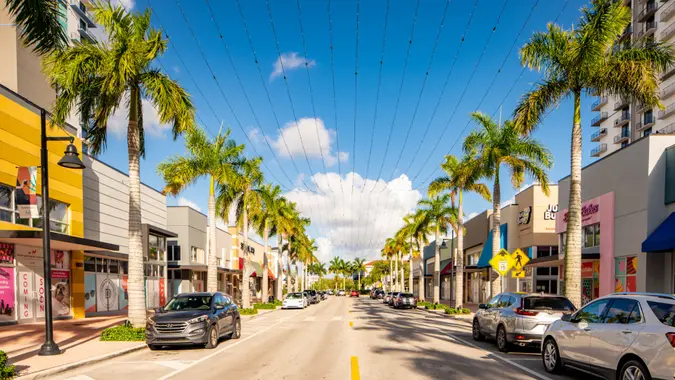6 Everyday Bills That Are Keeping Americans in a Debt Spiral

Commitment to Our Readers
GOBankingRates' editorial team is committed to bringing you unbiased reviews and information. We use data-driven methodologies to evaluate financial products and services - our reviews and ratings are not influenced by advertisers. You can read more about our editorial guidelines and our products and services review methodology.

20 Years
Helping You Live Richer

Reviewed
by Experts

Trusted by
Millions of Readers
Inflation and high interest rates have dominated the financial headlines for a few years now, and their effects are clearly being felt by American households. Credit card debt levels recently crested $1 trillion for the first time ever, and credit card delinquencies are back to pre-pandemic levels, in spite of a solid economy.
Indicative of the struggle, a new GOBankingRates survey of 999 adult Americans revealed that more than 32% of participants felt that “too many other bills/expenses” are standing in their way of paying off debt.
If you fall into this category yourself, it could help to analyze your expenses by category. According to the U.S. Department of Labor, these are the six largest expenses for the average American household, in order, including the average amount spent for a family of four.
By comparing your expenses with these national averages, you may be able to find areas where you can trim your costs and put more of your money towards paying down debt.
Housing (Including Utilities)
- Annual expenditure share: 33%
- Average category spending 2021: $22,624
- Average category spending 2022: $24,298
Housing expenditures, which include utilities, increased by 7% from 2021 to 2022. Lodging on out-of-town trips jumped by 38.6%.
Experts generally recommend that you spend no more than 30% of your income on housing, so if you’re over that line, this may be an area you should be trimming back on. As housing is by far the largest expense Americans have, there could be room to reduce costs by downsizing, moving to a more affordable neighborhood or, at some point in the future, possibly refinancing.
Transportation
- Annual expenditure share: 16.8%
- Average category spending 2021: $10,961
- Average category spending 2022: $12,295
Transportation costs rose by 12.2% from 2021 to 2022, driven in large part by an increase in gasoline prices. Those have fallen some since 2022, so this area might offer Americans a bit more breathing room in 2024.
If you’re looking to cut your transportation costs even more, consider ridesharing, taking public transportation or even using a bicycle to get to work and/or run your errands. If you absolutely need to drive a car, shop around for the best gas prices and consider swapping your newer car, if applicable, to a used or more inexpensive model.
Food
- Annual expenditure share: 12.8%
- Average category spending 2021: $8,289
- Average category spending 2022: $9,343
Food costs rose by more than 12% for Americans from 2021-22, as more began eating out again as the pandemic subsided.
Food is another category where it can be relatively easy to cut back on costs if your budget is getting out of control. As eating out is much more costly than shopping at a grocery store and eating at home, trimming your restaurant spending can easily save you hundreds of dollars a month, depending on how often you go out.
Personal Insurance and Pensions
- Annual expenditure share: 12.0%
- Average category spending 2021: $7,873
- Average category spending 2022: $8,742
Saving for retirement and having adequate insurance coverage are both essential expenses. Over the year from 2021 to 2022, spending on life and other personal insurance jumped by 9.7%.
While boosting retirement savings is a “good” expense, you’ll want to weigh your spending on insurance and even your pension plans against the cost of having credit card debt. If you’re paying 25% on an outstanding credit card balance, for example, you may want to trim your retirement savings at least temporarily until you can wipe out that debt. This is a great discussion to have with your financial advisor.
Healthcare
- Annual expenditure share: 8.0%
- Average category spending 2021: $5,452
- Average category spending 2022: $5,850
Healthcare costs can be hard to trim, as they are certainly essential. While no one likes to spend money on health insurance and doctor bills, as the saying goes, without your health, you don’t have anything. However, you can and should take the time to find the most affordable insurance you can that still covers all of your needs. You can also shop around if you need to undergo any procedures, as costs can vary dramatically from area to area and hospital to hospital.
Entertainment
- Annual expenditure share: 4.7%
- Average category spending 2021: $3,568
- Average category spending 2022: $3,458
Entertainment falls into the category of discretionary spending, meaning it’s money you don’t need to spend in order to survive. While everyone enjoys evenings out or watching multiple streaming services, if your spending exceeds your income, this is an easy cut to make.
Methodology: Data for this study was taken from both the U.S. Department of Labor and a May 2024 study conducted by GOBankingRates regarding debt and personal finances. It’s important to note that the U.S. DOL data is for 2022, which is the most recent year for which data is available. Still, the percentage breakdown of expenses by household generally remains similar from year to year.
 Written by
Written by  Edited by
Edited by 

























